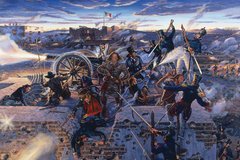Texas Essential Knowledge and Skills
4th Grade TEKS: 4.3D & E; 4.6B; 4.8A & B; 4.21B & C; 4.22
7th Grade TEKS: 7.1A & C; 7.2 D & F; 7.4A & B; 7.8; 7.9; 7.11A & B; 7.21; 7.22, 7.23
Map introduction
On December 19, 1836, the Congress of the Republic of Texas passed legislation defining the boundaries of its territory. The law stated: <i>That from the passage of this act, the civil and political jurisdiction of the republic be, and hereby declared to extend to the following boundaries, to wit:
beginning at the mouth of the Sabine river, and running west along the Gulf of Mexico three leagues from land, to the mouth of the Rio Grande, thence up the principal stream of said river to its source, thence due north to the forty-second degree of north latitude, thence along the boundary line as defined in the treaty between the United States and Spain, to the beginning: and that the president be, and is hereby authorized and required to open negotiation with the government of the United States of America, as soon as in his opinion the public interest requires it, to ascertain and define the boundary line as agreed to in said treaty.</i> This claim, which stretched the traditional boundary of Texas, guaranteed future conflicts.




















